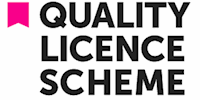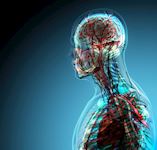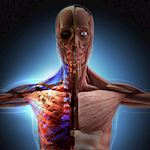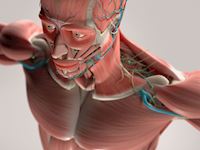Anatomy and Physiology Diploma Course
16 Modules | Lifetime Access | 7 Videos | Study Group Access
Centre of Excellence
Summary
- Certificate of completion - Free
- Exam(s) / assessment(s) is included in price
- TOTUM card available but not included in price What's this?
Add to basket or enquire
Overview
With so many incredible modern day advancements making our lives easier, there is something we frequently take for granted, something that is not new or technologically perfected, something simple yet complex and which we use every day without thought, our bodies. This accredited Anatomy and Physiology Course takes you on a journey through the incredible mass of cells that is your body. From head to toe and everything in-between, you’ll discover the structures, functions, and pathologies of the various systems and organs of the body and how they work independently and as a coherent whole.
The course begins by looking at the structural organisation of the whole body and the hierarchy of our body, from organism to atom, and how it maintains homoeostasis, and therefore correct body function, through regulation of metabolism. You’ll learn about the building blocks of the human body - cells, and the various types of tissues they can form.
Achievement
CPD
Course media
Description
The largest organ of the body, the skin, has more functions than you may first consider. The Anatomy & Physiology Diploma Course explores these functions and how the skin is constructed, including in-depth information about the dermis. You’ll also learn some interesting facts about the hair and nails, and the various pathologies of these, and the skin.
206 bones make up the framework for your body, known as the skeletal system. You’ll learn the function of the skeleton, the various types of bones and the structure of bone itself, including how it grows and develops. The divisions and purposes of the skeletal system are explained and the structure, functions and various types of joints are examined, along with the muscles and tendons that support them. The muscular system is also covered, including the function and structure of the different types of attachments of muscles, how muscles contract, and the position and action of muscles.
From the moment an item of food enters the mouth a process begins by which it is processed, digested, the nutrients absorbed, and unused materials removed. The Anatomy & Physiology Diploma Course follows the journey it takes, examining how each organ in the digestive system plays its part.
In a similar way, the course looks at the physiological process of respiration and the mechanical process of breathing. You’ll explore the components and subdivisions of the respiratory system, as each element is isolated and explained both anatomically and physiologically, to explain the respiratory system as a whole.
The Anatomy & Physiology Course provides an in-depth exploration of blood – its purpose depending on the type of cell, what it is made up of, and how it travels around the body via the cardiovascular system. You’ll gain a comprehensive understanding of the structure and functions of the heart and blood vessels (veins, arteries, and capillaries) and the pathologies of the heart and blood.
A good portion of the body’s immune system resides in the lymphatic system, which itself is part of the cardiovascular system. You’ll learn how lymph is formed, its purpose and connection with blood, the circulatory pathway of lymph, and the position of the main lymphatic nodes and organs of the body.
Hormones are produced and secreted by glands in the endocrine system. The Anatomy & Physiology Diploma Course defines the various types of hormones and guides you through their effects on the body and the main endocrine glands and function of the endocrine system.
The hormones work to control and support the reproductive system, whose purpose is to pass on genetic information to offspring. You’ll learn about the functions and structure of the parts of the female and male reproductive systems.
Consisting of the kidneys, ureters, bladder, and the urethra, the course goes into great detail about these individual parts of the urinary system and their functions as individual organs and as a system.
One of the most complex systems of the body, the nervous system, is covered extensively. You’ll learn how the system is organised and how each component functions including the brain, different types of neurones, the spine, nervous tissue, and how nerve impulses transmit.
We experience the world through our sensors, which take in various types of information and convert it into electrochemical impulses, which are sent to the nervous system. You’ll learn about the various sensors, looking more closely at how the eyes and ears work to provide us with vision and hearing.
Who is this course for?
An incredibly comprehensive study of the human body, the Anatomy & Physiology Diploma Course can be used by those going into higher education in the fields of medicine and biology. Similarly, practitioners of complementary and alternative therapies, treatments, and medicines will be able to improve their techniques by increasing their knowledge through studying this course.
If you have ever wondered how this tool that you use every day of your life actually functions, this course has the answers. With an overview of each system of the body, in-depth breakdowns of the structures and functions of their component parts, and pathologies of each, you will understand how the body works and the problems that can occur within it.
Requirements
There are no prerequisites, just an eagerness to learn and an internet connection.
Questions and answers
Currently there are no Q&As for this course. Be the first to ask a question.
Certificates
Certificate of completion
Digital certificate - Included
Reviews
Legal information
This course is advertised on reed.co.uk by the Course Provider, whose terms and conditions apply. Purchases are made directly from the Course Provider, and as such, content and materials are supplied by the Course Provider directly. Reed is acting as agent and not reseller in relation to this course. Reed's only responsibility is to facilitate your payment for the course. It is your responsibility to review and agree to the Course Provider's terms and conditions and satisfy yourself as to the suitability of the course you intend to purchase. Reed will not have any responsibility for the content of the course and/or associated materials.





